Maximilian Zorn
Surrogate Fitness Metrics for Interpretable Reinforcement Learning
Apr 20, 2025Abstract:We employ an evolutionary optimization framework that perturbs initial states to generate informative and diverse policy demonstrations. A joint surrogate fitness function guides the optimization by combining local diversity, behavioral certainty, and global population diversity. To assess demonstration quality, we apply a set of evaluation metrics, including the reward-based optimality gap, fidelity interquartile means (IQMs), fitness composition analysis, and trajectory visualizations. Hyperparameter sensitivity is also examined to better understand the dynamics of trajectory optimization. Our findings demonstrate that optimizing trajectory selection via surrogate fitness metrics significantly improves interpretability of RL policies in both discrete and continuous environments. In gridworld domains, evaluations reveal significantly enhanced demonstration fidelities compared to random and ablated baselines. In continuous control, the proposed framework offers valuable insights, particularly for early-stage policies, while fidelity-based optimization proves more effective for mature policies. By refining and systematically analyzing surrogate fitness functions, this study advances the interpretability of RL models. The proposed improvements provide deeper insights into RL decision-making, benefiting applications in safety-critical and explainability-focused domains.
Evaluating Mutation Techniques in Genetic Algorithm-Based Quantum Circuit Synthesis
Apr 08, 2025Abstract:Quantum computing leverages the unique properties of qubits and quantum parallelism to solve problems intractable for classical systems, offering unparalleled computational potential. However, the optimization of quantum circuits remains critical, especially for noisy intermediate-scale quantum (NISQ) devices with limited qubits and high error rates. Genetic algorithms (GAs) provide a promising approach for efficient quantum circuit synthesis by automating optimization tasks. This work examines the impact of various mutation strategies within a GA framework for quantum circuit synthesis. By analyzing how different mutations transform circuits, it identifies strategies that enhance efficiency and performance. Experiments utilized a fitness function emphasizing fidelity, while accounting for circuit depth and T operations, to optimize circuits with four to six qubits. Comprehensive hyperparameter testing revealed that combining delete and swap strategies outperformed other approaches, demonstrating their effectiveness in developing robust GA-based quantum circuit optimizers.
Investigating Parameter-Efficiency of Hybrid QuGANs Based on Geometric Properties of Generated Sea Route Graphs
Jan 15, 2025Abstract:The demand for artificially generated data for the development, training and testing of new algorithms is omnipresent. Quantum computing (QC), does offer the hope that its inherent probabilistic functionality can be utilised in this field of generative artificial intelligence. In this study, we use quantum-classical hybrid generative adversarial networks (QuGANs) to artificially generate graphs of shipping routes. We create a training dataset based on real shipping data and investigate to what extent QuGANs are able to learn and reproduce inherent distributions and geometric features of this data. We compare hybrid QuGANs with classical Generative Adversarial Networks (GANs), with a special focus on their parameter efficiency. Our results indicate that QuGANs are indeed able to quickly learn and represent underlying geometric properties and distributions, although they seem to have difficulties in introducing variance into the sampled data. Compared to classical GANs of greater size, measured in the number of parameters used, some QuGANs show similar result quality. Our reference to concrete use cases, such as the generation of shipping data, provides an illustrative example and demonstrate the potential and diversity in which QC can be used.
Optimizing Sensor Redundancy in Sequential Decision-Making Problems
Dec 10, 2024



Abstract:Reinforcement Learning (RL) policies are designed to predict actions based on current observations to maximize cumulative future rewards. In real-world applications (i.e., non-simulated environments), sensors are essential for measuring the current state and providing the observations on which RL policies rely to make decisions. A significant challenge in deploying RL policies in real-world scenarios is handling sensor dropouts, which can result from hardware malfunctions, physical damage, or environmental factors like dust on a camera lens. A common strategy to mitigate this issue is the use of backup sensors, though this comes with added costs. This paper explores the optimization of backup sensor configurations to maximize expected returns while keeping costs below a specified threshold, C. Our approach uses a second-order approximation of expected returns and includes penalties for exceeding cost constraints. We then optimize this quadratic program using Tabu Search, a meta-heuristic algorithm. The approach is evaluated across eight OpenAI Gym environments and a custom Unity-based robotic environment (RobotArmGrasping). Empirical results demonstrate that our quadratic program effectively approximates real expected returns, facilitating the identification of optimal sensor configurations.
Swarm Behavior Cloning
Dec 10, 2024Abstract:In sequential decision-making environments, the primary approaches for training agents are Reinforcement Learning (RL) and Imitation Learning (IL). Unlike RL, which relies on modeling a reward function, IL leverages expert demonstrations, where an expert policy $\pi_e$ (e.g., a human) provides the desired behavior. Formally, a dataset $D$ of state-action pairs is provided: $D = {(s, a = \pi_e(s))}$. A common technique within IL is Behavior Cloning (BC), where a policy $\pi(s) = a$ is learned through supervised learning on $D$. Further improvements can be achieved by using an ensemble of $N$ individually trained BC policies, denoted as $E = {\pi_i(s)}{1 \leq i \leq N}$. The ensemble's action $a$ for a given state $s$ is the aggregated output of the $N$ actions: $a = \frac{1}{N} \sum{i} \pi_i(s)$. This paper addresses the issue of increasing action differences -- the observation that discrepancies between the $N$ predicted actions grow in states that are underrepresented in the training data. Large action differences can result in suboptimal aggregated actions. To address this, we propose a method that fosters greater alignment among the policies while preserving the diversity of their computations. This approach reduces action differences and ensures that the ensemble retains its inherent strengths, such as robustness and varied decision-making. We evaluate our approach across eight diverse environments, demonstrating a notable decrease in action differences and significant improvements in overall performance, as measured by mean episode returns.
Finding Strong Lottery Ticket Networks with Genetic Algorithms
Nov 07, 2024Abstract:According to the Strong Lottery Ticket Hypothesis, every sufficiently large neural network with randomly initialized weights contains a sub-network which - still with its random weights - already performs as well for a given task as the trained super-network. We present the first approach based on a genetic algorithm to find such strong lottery ticket sub-networks without training or otherwise computing any gradient. We show that, for smaller instances of binary classification tasks, our evolutionary approach even produces smaller and better-performing lottery ticket networks than the state-of-the-art approach using gradient information.
REACT: Revealing Evolutionary Action Consequence Trajectories for Interpretable Reinforcement Learning
Apr 04, 2024Abstract:To enhance the interpretability of Reinforcement Learning (RL), we propose Revealing Evolutionary Action Consequence Trajectories (REACT). In contrast to the prevalent practice of validating RL models based on their optimal behavior learned during training, we posit that considering a range of edge-case trajectories provides a more comprehensive understanding of their inherent behavior. To induce such scenarios, we introduce a disturbance to the initial state, optimizing it through an evolutionary algorithm to generate a diverse population of demonstrations. To evaluate the fitness of trajectories, REACT incorporates a joint fitness function that encourages both local and global diversity in the encountered states and chosen actions. Through assessments with policies trained for varying durations in discrete and continuous environments, we demonstrate the descriptive power of REACT. Our results highlight its effectiveness in revealing nuanced aspects of RL models' behavior beyond optimal performance, thereby contributing to improved interpretability.
Quantum Advantage Actor-Critic for Reinforcement Learning
Jan 13, 2024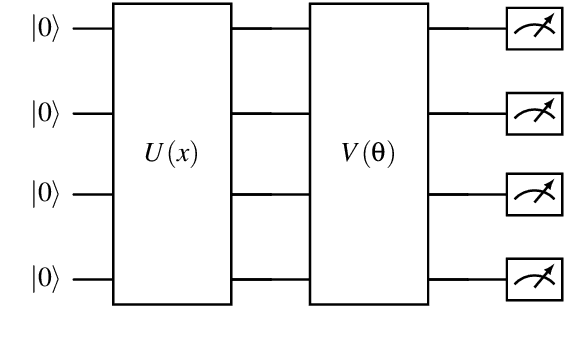
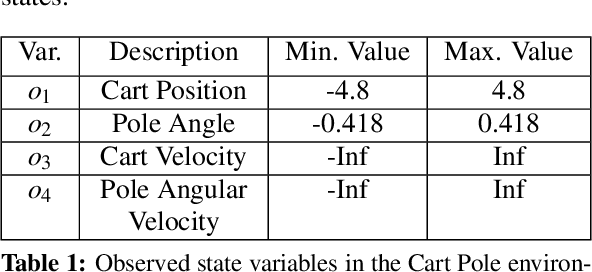

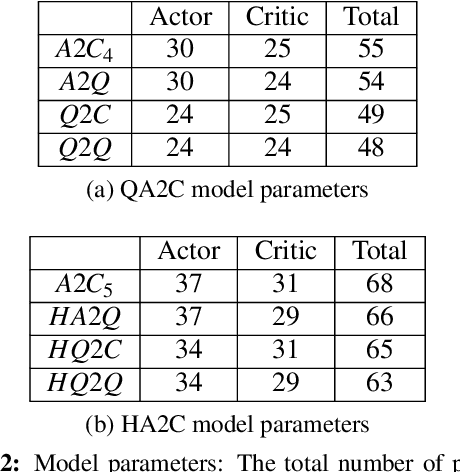
Abstract:Quantum computing offers efficient encapsulation of high-dimensional states. In this work, we propose a novel quantum reinforcement learning approach that combines the Advantage Actor-Critic algorithm with variational quantum circuits by substituting parts of the classical components. This approach addresses reinforcement learning's scalability concerns while maintaining high performance. We empirically test multiple quantum Advantage Actor-Critic configurations with the well known Cart Pole environment to evaluate our approach in control tasks with continuous state spaces. Our results indicate that the hybrid strategy of using either a quantum actor or quantum critic with classical post-processing yields a substantial performance increase compared to pure classical and pure quantum variants with similar parameter counts. They further reveal the limits of current quantum approaches due to the hardware constraints of noisy intermediate-scale quantum computers, suggesting further research to scale hybrid approaches for larger and more complex control tasks.
A Reinforcement Learning Environment for Directed Quantum Circuit Synthesis
Jan 13, 2024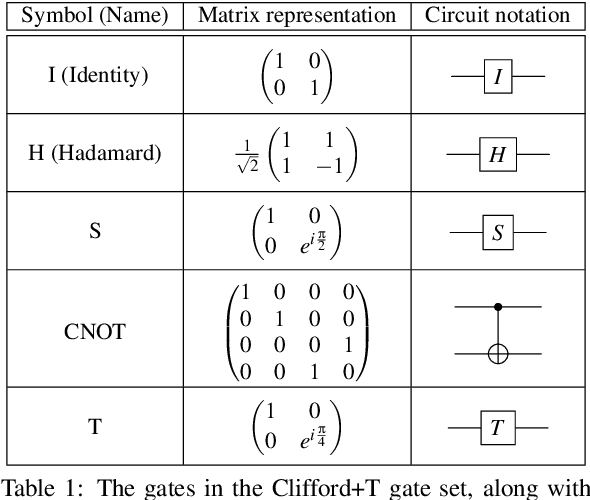
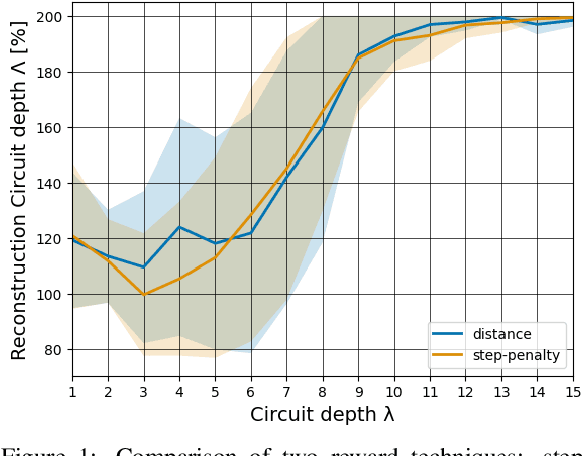
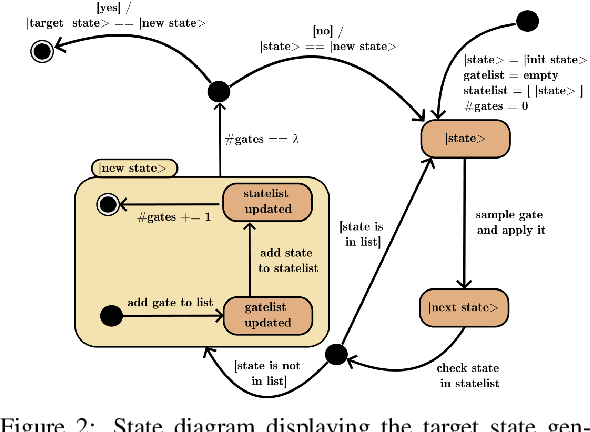
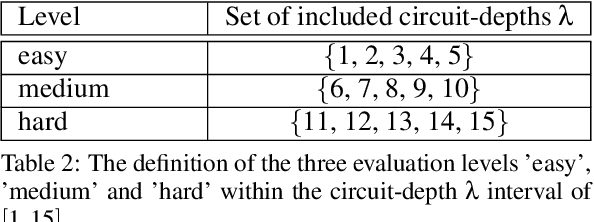
Abstract:With recent advancements in quantum computing technology, optimizing quantum circuits and ensuring reliable quantum state preparation have become increasingly vital. Traditional methods often demand extensive expertise and manual calculations, posing challenges as quantum circuits grow in qubit- and gate-count. Therefore, harnessing machine learning techniques to handle the growing variety of gate-to-qubit combinations is a promising approach. In this work, we introduce a comprehensive reinforcement learning environment for quantum circuit synthesis, where circuits are constructed utilizing gates from the the Clifford+T gate set to prepare specific target states. Our experiments focus on exploring the relationship between the depth of synthesized quantum circuits and the circuit depths used for target initialization, as well as qubit count. We organize the environment configurations into multiple evaluation levels and include a range of well-known quantum states for benchmarking purposes. We also lay baselines for evaluating the environment using Proximal Policy Optimization. By applying the trained agents to benchmark tests, we demonstrated their ability to reliably design minimal quantum circuits for a selection of 2-qubit Bell states.
Improving Parameter Training for VQEs by Sequential Hamiltonian Assembly
Dec 09, 2023Abstract:A central challenge in quantum machine learning is the design and training of parameterized quantum circuits (PQCs). Similar to deep learning, vanishing gradients pose immense problems in the trainability of PQCs, which have been shown to arise from a multitude of sources. One such cause are non-local loss functions, that demand the measurement of a large subset of involved qubits. To facilitate the parameter training for quantum applications using global loss functions, we propose a Sequential Hamiltonian Assembly, which iteratively approximates the loss function using local components. Aiming for a prove of principle, we evaluate our approach using Graph Coloring problem with a Varational Quantum Eigensolver (VQE). Simulation results show, that our approach outperforms conventional parameter training by 29.99% and the empirical state of the art, Layerwise Learning, by 5.12% in the mean accuracy. This paves the way towards locality-aware learning techniques, allowing to evade vanishing gradients for a large class of practically relevant problems.
 Add to Chrome
Add to Chrome Add to Firefox
Add to Firefox Add to Edge
Add to Edge